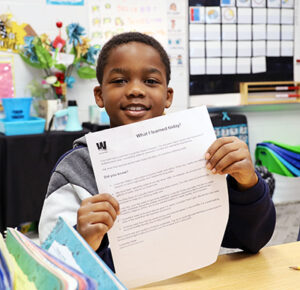 “Where do we get our water?” Louisville Water educator Debbie Trahan asked a class of Kenwood Station Elementary School students.
“Where do we get our water?” Louisville Water educator Debbie Trahan asked a class of Kenwood Station Elementary School students.
“The Ohio River!” they shouted.
Trahan held up a test tube filled with brown water. Then she held up a test tube full of clear water. The students were eager to find out how Louisville Water Company turns the muddy water into clear, great-tasting drinking water.
The third graders learned about treatment processes and about the company’s scientists, who do more than 200 tests every day to make sure the water the students and their families drink is always safe.
 The lesson, “Ohio River: Protecting Our Water Source,” strongly aligned with the Earth Month goal of raising environmental awareness. The third graders studied the geography of the river and found out that it’s the source for more than five million people in six states.
The lesson, “Ohio River: Protecting Our Water Source,” strongly aligned with the Earth Month goal of raising environmental awareness. The third graders studied the geography of the river and found out that it’s the source for more than five million people in six states.
The lesson also made the students “aware of the pollution that is generated at different sites and possible solutions to help reduce it,” Trahan said.
One of the solutions that the students learned is to drink water from the tap instead of bottled water. They realized this is an environmentally friendly way to stay hydrated because it reduces the amount of single-use plastic bottles that end up in landfills.
 Pure Tap fun fact: Louisville Water helped save more than 7.5 million bottles from landfills during just the past year. That’s the number of reusable bottles that were filled at our 129 branded bottle-filling stations at our 21 partner locations and in our own facilities.
Pure Tap fun fact: Louisville Water helped save more than 7.5 million bottles from landfills during just the past year. That’s the number of reusable bottles that were filled at our 129 branded bottle-filling stations at our 21 partner locations and in our own facilities.
Trahan used videos, worksheets, and classroom activities to reinforce the Ohio River lesson. She pointed out that the recent flooding on the river “generated interest in the Ohio and enriched our discussions about it. It gave them a lot of background knowledge.”

The students even received a take-home worksheet to share with their parents that emphasized Louisville Water’s quality standards for drinking water, which are set above the already strict health standards required by the Environmental Protection Agency.
Trahan said she especially likes presenting the Ohio River lesson because it helps students understand “how important the Ohio River is to the communities around it” and “how the river has a direct impact on them.”

